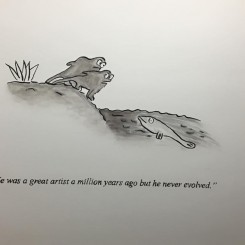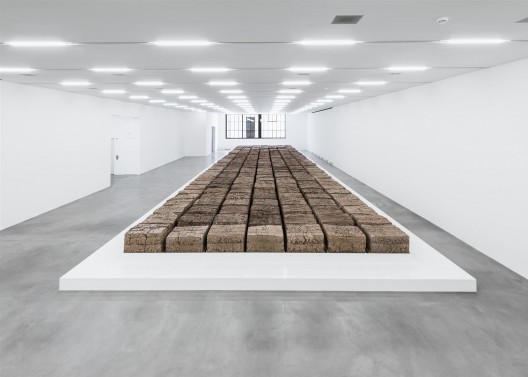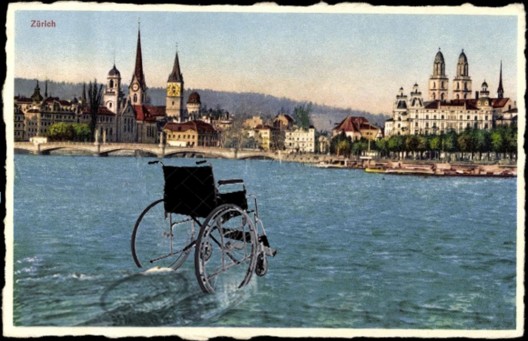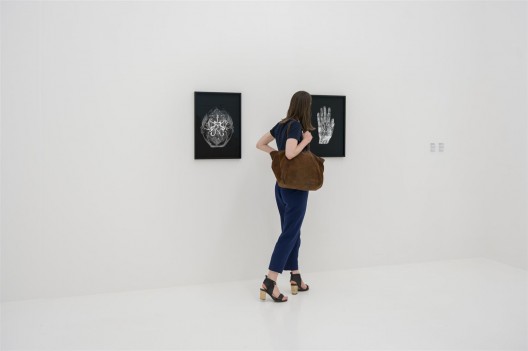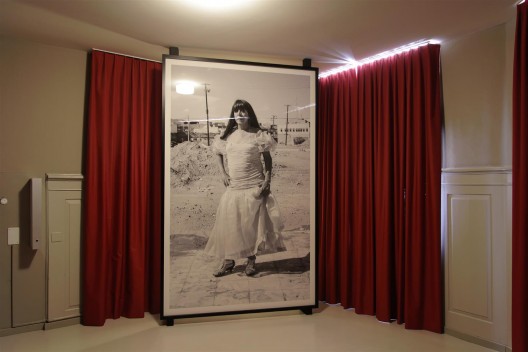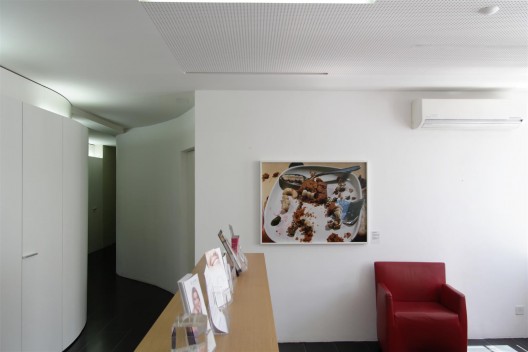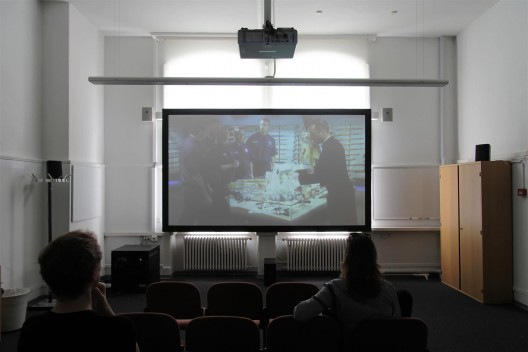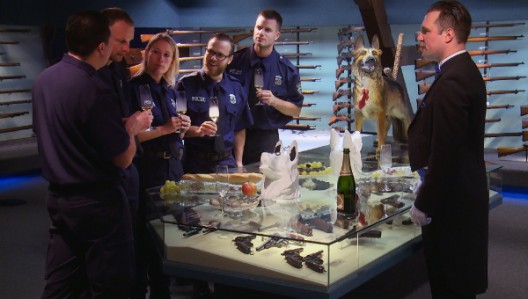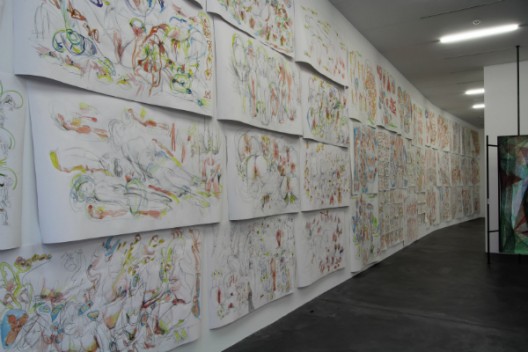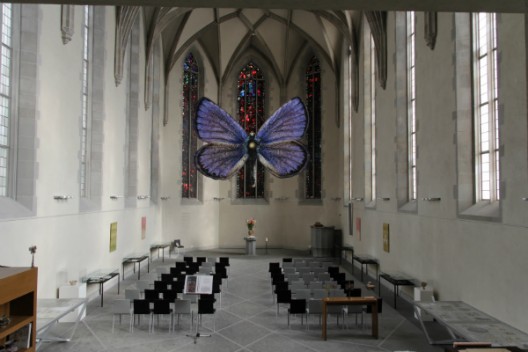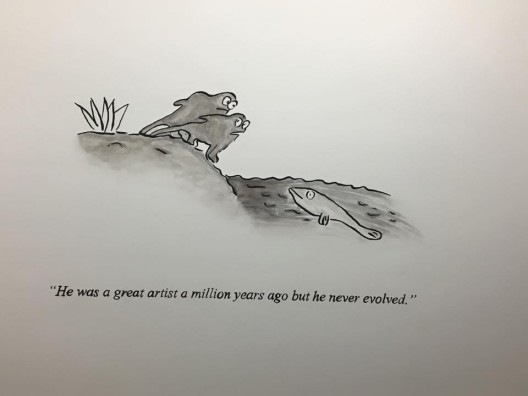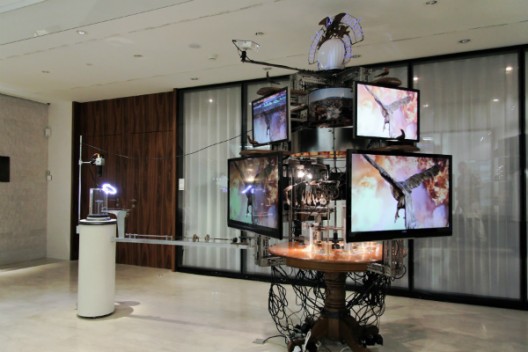The European Biennial of Contemporary Art (various venues, Zurich, Switzerland), Jun 6–Sept 9, 2016
80,000 kg of human excrement in an art gallery, a Paralympian spinning her wheelchair across Lake Zurich and mournful, lovelorn robots are some of the more entertaining works in Manifesta 11. Curated by the artist Christian Jankowski and entitled “What People Do for Money: Some Joint Ventures”, the 11th edition of Europe’s roving biennial is simultaneously comedic and tame.
Each of the thirty participating artists in the exhibition chose a “host”—a professional from the city of Zurich. These ranged from sewage workers to dentists, firefighters, engineers, and dog stylists. The resulting new commissions are displayed around the city and at the main exhibition sites: the Löwenbräu-Areal, a former brewery-turned-art site, and the Helmhaus, a historic building in downtown Zurich.
Art has a long preoccupation with labor, from Dutch Renaissance paintings of farm laborers and Lowry’s bleak images of factory workers in Northern England to contemporary neo-Marxist theory. But Jankowski’s aim is not to contribute to this tradition by investigating the meaning and iconography of labor in the 21st century. With his curatorial strategy of pairing artists with professionals and approach of exhibiting the resulting works in locations from fire stations to dog parlors, he aims to extend art into real life in order to create absurd theatrical situations that extend the boundaries of both labor and art. Labor—and its images, from scans of Michel Houellebeq’s spleen to watercolors of orgasming women—are aestheticized and rendered as artistic gesture.
This is, of course, part of the Jankowskian M.O.: as an artist, he has collaborated with everyone from politicians to priests and wrestlers. Realized on the scale of a biennial, with over 30 satellite sites to be visited in addition to the main Löwenbräu-Areal and Helmhaus spaces, however, Jankowski’s method shows its limitations. Marco Schmitt’s version of Luis Buñuel’s 1962 film The Exterminating Angel has the Zurich Police force engage in a macabre dinner in the Museum of Crime. Located in a side room at the Zurich police academy, the setting neither particularly adds nor detracts from the film: it is, in the end, just another bland room in a perfunctionarily refurbished nineteenth-century building. The partner piece in the Löwenbräu-Areal—each offsite has a corresponding work in one of the two main venues—is an installation of German shepherds and panthers snarling at each other. It is not clear how the pairing functions, nor how the separate pieces relate to each other. Other works devolve into Situationist comedy: the dentist’s office with Torbjørn Rødland’s photographs of decaying dentistry, for instance (“Mathew Mark Luke John and Other Photographs”). The receptionist confided to Ran Dian that they took the photographs down during practice hours to avoid frightening the patients.
To read Manifesta 11 as a Jankowskian artwork on a large scale is to render the participating artists a disservice because they follow other, often conflicting aims. Yet it is intriguing to see how the artists most aligned with Jankowski’s approach—i.e. whose practice involves large-scale project management—have produced the strongest works. This includes Marguerite Humeau’s piece “When Skies Above Were Not Yet Named, 1″, realized in the Machine Laboratory of Zurich’s technical university, the ETH. The artist designed two autonomous robots modeled on cynodonts (early warm-blooded creatures). Connected via wifi and hormonal vapors, the robots circle each other deep in the bowels of the lab, falling in and out of love. Humeau’s sense of the absurd elevates this otherwise stentorian piece: is she critiquing love, thinking about machine emotion or just testing the limits of her practice? Likewise, Mike Bouchet’s installation of 80,000 kg of human excrement produced by the citizens of Zurich on March 24 2016 takes the Beuyssian concept of the social sculpture to new heights: Beuys famously claimed “everyone is an artist” and contribute to the work of art that is society as a whole. A room full of treated and compressed human excrement being displayed as art is also a tongue-in-cheek comment both the nature of art and the act of ennoblement that follows the declaration of an object as a work of art.
To artistically anchor the new commissions, Francesca Gavin has curated a “Historical Exhibition: Sites under Construction” which unites artists who take labor as both their subject and their aesthetic. Loosely divided into nine thematic sections, from the self-reflective “Professions in the Art World” to “Portraits of Professions”, this races from Sophie Calle’s hiring a detective to follow her around Paris to Simon Denny’s intricate blockchain installation and Kim Gordon’s glitter circle. While the links between artworks and sections may be tenuous, Gavin has assembled an impressive oeuvre of works that reflect on the relationships between different forms of labor.
As a whole, the biennial stutters and falters. Jankowski’s willfully naïve investigation into labor as art—he even hired Zurich school children as “art detectives” to produce “making of” films that are shown in a floating pavilion on Lake Zurich—cannot escape wider questions regarding how labor is constructed in the 21st century. The works fail to penetrate metaquestions regarding precariousness and insecurity: indeed, the only piece to thematize the risks inherent in labor is Teresa Margolles’s “Poker de Damas”, a film in which a Zurich transgender sex worker plays poker with two Mexican counterparts. Intended to be staged as Tableau Vivant in a hotel in Zurich’s red light district, this plan was abandoned owing to the murder of Karla, one of the participants, in December 2015. The empty room contains a somber sound installation narrating the circumstances of the murder.
The off-sites in Manifesta 11 often feel rather arbitrary. The artworks are inserted with no consequence or real interaction, with the conceptual elements of each joint venture losing out to the primacy of art’s aesthetic status. While this once again raises questions about the limits of art, its presentation and spaces, nowhere does the biennial address this directly. A stroll around the off-sites on a sunny day may make for a pleasant diversion, but the visitor is left hankering for a clearer assessment of the relationship between art and labor today.
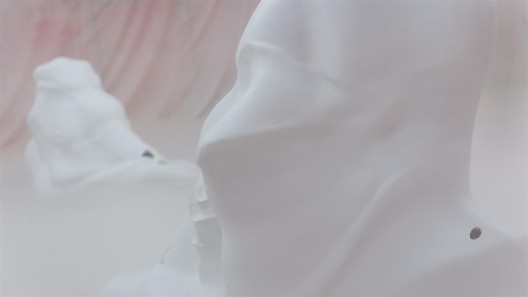
Marguerite Humeau, “When Skies are not named yet (I)”, installation at Satellite ETH. Copyright Manifesta11/Eduard Meltzer.

